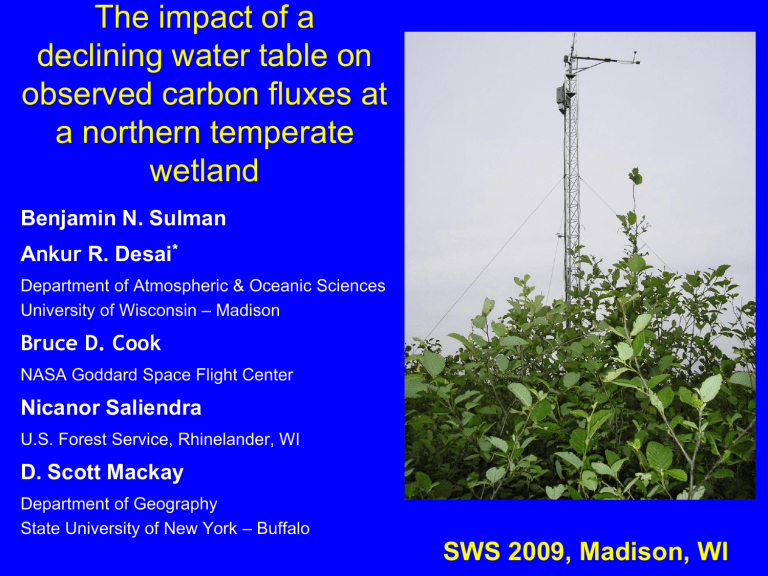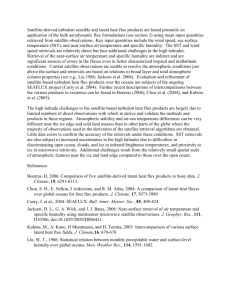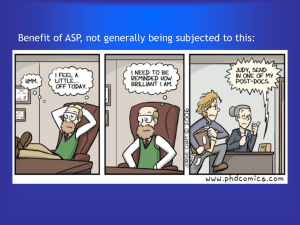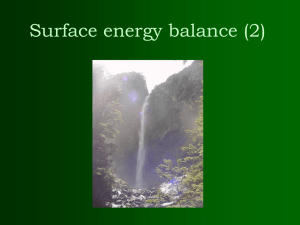Water, biology, and climate in northern Wisconsin

The impact of a declining water table on observed carbon fluxes at a northern temperate wetland
Benjamin N. Sulman
A nkur
R. Desai
*
Department of Atmospheric & Oceanic Sciences
University of Wisconsin – Madison
Bruce D. Cook
NASA Goddard Space Flight Center
Nicanor Saliendra
U.S. Forest Service, Rhinelander, WI
D. Scott Mackay
Department of Geography
State University of New York
– Buffalo
SWS 2009, Madison, WI
Projected climate changes affecting northern wetlands
• Higher temperatures, more precipitation
• But: Net drying due to more evaporation
• Poleward shift of biomes
Question: How will changes in hydrology affect interactions between wetlands and climate?
Focus: Water table and carbon cycle
Wetlands and climate
• Biogeochemical: Carbon cycle
– In Northern Highlands region of Wisconsin, wetlands have over half the carbon pool
• Biophysical: Evapotranspiration
– Atmospheric heat and moisture budgets strongly mediated by surface sensible and latent heat fluxes
Northern Highlands
Wisconsin Online http://www.wisconline.com/wisconsin/geoprovinces/northernhighland.html
Biogeochemical interactions:
Existing literature is contradictory
• Modeling studies have identified a climate feedback (e.g. Ise et al. 2008)
• Observations have mixed results
– Lowering water table increased CO
2 emission or changed wetlands from a carbon sink to a source:
(Silvola et al. 1996, Alm et al. 1999, Bubier at al.
2003)
– No correlation between water table and CO
2 emission: (Updegraff et al. 2001, Lafleur et al.
2005)
Biophysical interactions:
How does drying a wetland affect the energy and moisture budgets of the atmosphere?
Case 1: High water table Case 2: Low water table
High sensible heat loss
High latent heat loss
Low sensible heat loss Low latent heat loss
Declining water table
Long-term drying in N. WI
Courtesy of C. Kucharik, UW-Madison SAGE
Lost Creek
• Alder-willow fen
• Poorly drained sapric muck
• Flux tower established
2001
South Fork and Wilson
Flowage
• Wetland sites
• SF: Ericaceous bog
• WF: Grass-sedge-shrub fen
• Three years (2005-
2007) of growing season flux data with roving tower
• Switched between sites every two weeks
Eddy Covariance
Turbulent flux Storage
Equipment:
• 3D sonic anemometer
• Open or closed path gas analyzer
• Multiple level CO
2 profiler
•10Hz temporal resolution -> 30 min fluxes
Terms
• Net Ecosystem Exchange ( NEE )
– Total net carbon flux (measured)
• Ecosystem Respiration ( ER )
– Carbon released to atmosphere
• Gross Ecosystem Production ( GEP )
– Carbon absorbed from atmosphere
• Evapotranspiration ( ET )
– Water / latent heat flux
• Water table height ( WT )
• Positive = above surface
ER
NEE
GEP
Lost
Creek
Wilson
Flowage
Willow
Creek
(forest)
Flux observations
Lower WT increases ER
WT effect is independent of soil temperature
Lower WT increase GEP
NEE is independent of WT
Lower WT decreases ET
Water table
ET
Energy balance is changing
Net radiation
Latent heat flux
Sensible heat flux
Heat flux into ground
Findings summary
• Biogeochemical interactions:
– Both ER and GEP increased as water table declined
– Net ecosystem CO
2 exchange was independent of WT
– This supports literature arguing against a strong north temperate wetland water table-carbon feedback
• Biophysical interactions:
– ET declined and energy balance shifted in favor of higher sensible heat flux
– This could potentially be a positive feedback to warming and drying trends
• More results in:
– Sulman et al. (2009) Biogeosciences, in press
– Mackay et al. (2007) Water Resources Research
Ecosystem models simulate wetlands poorly
Needs
• Long-term observations of water table, carbon cycle, energy balance
• Better characterization of climate trends in wetland extensive areas
• Improve mechanistic understanding of hydrologic interaction with wetland carbon cycling
Models can be made better
Acknowledgements
• Jonathan Thom, UW-Madison
• Ron Teclaw and Dan Baumann, USDA Northern Research
Station, Rhinelander, WI
• Paul Bolstad, University of Minnesota
• Jon Martin, Oregon State University
• Sudeep Samanta, Woods Hole Research Center
• Bashkar Mitra, SUNY-Buffalo
This research was sponsored by the Department of
Energy (DOE) Office of Biological and Environmental
Research (BER) National Institute for Climatic Change
Research (NICCR) Midwestern Region Subagreement
050516Z19.






